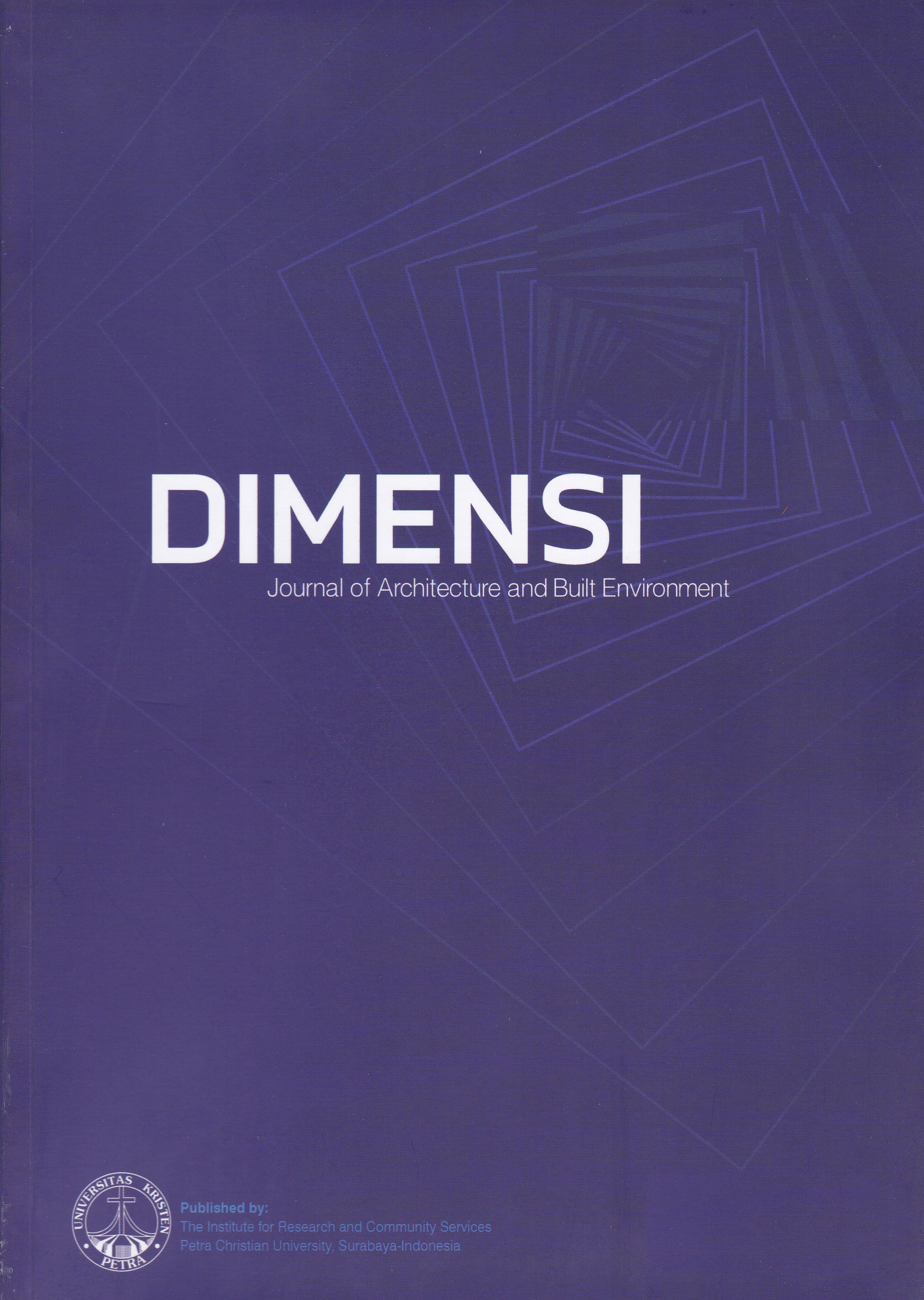IMPROVING PUBLIC AWARENESS OF EARTHQUAKE-RESISTANT HOUSE USING FACTOR ANALYSIS
 :
:
https://doi.org/10.9744/dimensi.47.1.43-54
Abstract
Public awareness of earthquake-resistant houses can increase the region's resilience to earthquake disasters. This study aims to conduct a comparison of two different groups of people on their opinion of earthquake-resistant housing variables and actions to increase the quality of their house. For supporting public awareness of earthquake-resistant houses, the purpose also determines the latent variables of earthquake-resistant houses and actions from the public for improving the quality of the residential building. This quantitative research begins by collecting the earthquake-resistant house attributes through journal reviews. This study used a closed-ended questionnaire to collect data on public experiences of earthquake disasters. For data analysis, it used correlation analysis to determine the level of relationship between two variables and utilizes factor analysis to reduce the variable to a small number of factors. The two groups that have different experiences of earthquakes tend to have similar opinions about the characteristics of earthquake-resistant houses and the actions for improving the quality of residential buildings. The five factors of the earthquake-resistant housing are safe structural construction, fixed architectural elements, open accessibility, lightweight-ductile material, and simple floor plan. Then the three factors represent the actions for improving residential quality, namely, to improve material and structure, build an earthquake-resistant house, and make accessibility easy and safe.
Downloads
References
Abdi, H., Williams, L.J. (2010). Principal Component Analysis. Wiley Interdisciplinary Reviews: Computational Statistics, Vol. 2, No. 4, 433-459.
Arya, A.S., Boen, T., Ishiyama, Y. (2014). Guidelines for Earthquake Resistant Non-Engineered Construction. United Nations Educational, Scientific and Cultural Organization. France.
BNPB (2014). Indeks risiko bencana Indonesia tahun 2013, Direktorat Pengurangan Risiko Bencana Deputi Bidang Pencegahan dan Kesiapsiagaan.
Croasmun, J.T. & Ostrom, L. (2011). Using Likert-Type Scales in the Social Sciences. Journal of Adult Education, Vol. 40, No. 1, 19 – 22.
Cronbach, L.J. (1951). Coefficient alpha and the internal structure of tests. Psychometrika, Vol 16, 3, 297 – 334.
Damayanti, P. & Sagala, S. (2013). Kesiapan Fisik Rumah Masyarakat terhadap Potensi Gempa Bumi di Lembang, Jawa Barat. Working Paper Series Resilience Development Initiative., No. 1, Oktober.
Geospasial BNPB (2013). Peta Indeks Rawan Bencana Indonesia 2012, http://geospasial.bnpb.go.id/wp-content/uploads/2016/ 03/2013-0513_peta_IRBI_2013_rev.jpg. Diunduh tanggal 5 Desember 2016
Hariyanto, A.D., Triyadi, S., Kusuma, H.E. (2016). Pemahaman Masyarakat terhadap Faktor Struktural dan Non-struktural Rumah Tahan Gempa, Prosiding Seminar Nasional Temu Ilmiah IPLBI 2016, IPLBI dan ITN Malang.
Harmankaya, Z.Y. & Soyluk, A. (2012). Architectural Design of Irregular Buildings in Turkey. International Journal of Civil & Environmental Engineering IJCEE-IJENS , Vol. 12, No. 01, 42-48.
IFRC & RCS (2011). Public awareness and public education for disaster risk reduction: a guide. International Federation of Red Cross and Red Crescent Societies.Geneva.
Kaiser, H.F. (1960) The application of electronic computers to factor analysis. Educational and Psychological Measurement, 20(1), pp.141-151.
Kateri, M. (2014). Contingency Table Analysis: Methods and Implementation Using R, Springer, New York.
Kung, Y. W., Chen, S. H. (2012). Perception of earthquake risk in Taiwan: Effects of gender and past earthquake experience. Risk Analysis, Vol 32, No. 9, 1535-1546
Kusumastuti, D., Pribadi, K.S., dan Rildov (2008). Reducing Earthquake Vulnerability of Non-Engineered Buidings: Case Study of Retrofitting of School Building in Indonesia. The 14th World Conference on Earthquake Engineering. Beijing, China.
Jolliffe, I.T. (2002). Principal Component Analysis, 2nd ed., Springer, New York.
Mora, K., Chang, J., Beatson, A., Morahan, C. (2015). Public perceptions of building seismic safety following the Canterbury earthquakes: A qualitative analysis using Twitter and focus groups. International Journal of Disaster Risk Reduction, 13, 1–9. Elsevier Ltd.
Neuman, L.W. (2014). Social Research Methods: Qualitative and Quantitative Approaches. Pearson Education Limited, USA.
Riduwan & Sunarto, H. (2010). Pengantar Statistika untuk Penelitian: Pendidikan, Sosial, Komunikasi, Ekonomi, dan Bisnis, Penerbit Alfabeta, Bandung.
Singh, S.R., Eghdami, M.R. & Singh, S. (2014). The Concept of Social Vulnerability: A Review from Disasters Perspectives. International Journal of Interdisciplinary and Multidisciplinary Studies (IJIMS), Vol 1, No.6, 71-82. http://www.ijims.com. Diunduh 1 Maret 2017.
Sugiyono (2017) Metode Penelitian Kuantitatif Kualitatif dan R&D, Penerbit Alfabeta, Bandung.
Ozmen, C., & Unay, A.I. (2007). Commonly encountered seismic design faults due to the architectural design of residential buildings in Turkey. Building and Environment ,42, 1406–1416. Elsevier Ltd.
Vicente, R., Ferreira, T.M., Maio, R., Koch, H. (2014) Awareness, Perception and Communication of Earthquake Risk in Portugal: Public Survey, Procedia Economics and Finance,18, 271 – 278.
Downloads
Published
How to Cite
Issue
Section
License
Authors who publish with this journal agree to the following terms:
- Authors retain copyright and grant the journal right of first publication with the work simultaneously licensed under a Creative Commons Attribution License that allows others to share the work with an acknowledgement of the work's authorship and initial publication in this journal.
- Authors are able to enter into separate, additional contractual arrangements for the non-exclusive distribution of the journal's published version of the work (e.g., post it to an institutional repository or publish it in a book), with an acknowledgement of its initial publication in this journal.
- Authors are permitted and encouraged to post their work online (e.g., in institutional repositories or on their website) prior to and during the submission process, as it can lead to productive exchanges, as well as earlier and greater citation of published work (See The Effect of Open Access).


















